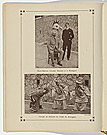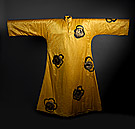Le Chant du Rossignol [The Song of the Nightingale]
Choreographic poem in one act
- Producer: Les Ballets Russes de Serge Diaghilev
- Premiere: 2 February 1920, Théâtre national de l’Opéra, Paris
- Costume design: Henri Matisse
- Costumier: Marie Muelle
- Scenery design: Henri Matisse
- Music: Igor Stravinsky
- Choreography: Léonide Massine
- Libretto: After the story by Hans Christian Andersen
- Main characters: The Nightingale, the Emperor of China, the Mechanical Nightingale, the Japanese Maestro, Death, Mandarins, chamberlains, mourners
The setting is the court of the Chinese Emperor, who owns a nightingale that sings for the court’s entertainment. However, the Japanese Emperor arrives for a visit, bearing a gift of a mechanical nightingale. The Chinese Emperor and his court are overjoyed with the new toy and soon the real nightingale leaves, neglected. Later, the Chinese Emperor becomes ill and on his death bed requests music be played. Just as he is about to die, the real nightingale returns to the palace and begins to sing, promising to continue if Death relents. The bargain is kept, the Emperor recovers and the Nightingale is restored to its former position in his court.
Based on a Hans Christian Andersen fairytale of the same name, this production was adapted from Stravinsky’s opera, Le Rossignol, produced by Diaghilev in 1914. The original opulent orientalist set and costumes by Benois were destroyed during the First World War, a loss that stimulated Diaghilev to commission a new ballet version which, following his successful engagements with Picasso and Derain, he hoped would be designed by another major artist. In 1919, he visited Henri Matisse to persuade him to design his new production, and was delighted to discover Matisse’s collection of exotic birds and his admiration of Massine’s choreography. Matisse had no theatre experience but took the commission with enthusiasm, determined to produce a design that was different from the high-keyed exoticism associated with the Ballets Russes. Using light colours against a porcelain-white backdrop, his refined costumes were based on traditional Chinese Ming court dress in colour orchestrations derived from Chinese ceramics and lacquer. The courtiers’ costumes were elaborately tailored in silk, with loose decorations painted and directed by Matisse. Their massing on stage created the impression of a continuous pattern, as if on a scroll painting. The final unfurling of the recovered Emperor’s long vermilion cloak was a calligraphic gesture, contrasting with the massed graphic of the black and white clad mourners at his feet. Their animal-like cloaks, among the most breathtaking of Matisse’s designs, were made from a white felt-like curtain lining material with appliquéd triangles and chevrons of navy blue velvet, inspired by the markings on Chinese deer.









